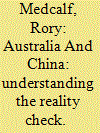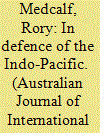|
|
|
Sort Order |
|
|
|
Items / Page
|
|
|
|
|
|
|
| Srl | Item |
| 1 |
ID:
165201


|
|
|
|
|
| Summary/Abstract |
Between 2016 and 2018, Australia’s perceptions of China underwent a significant reality check, with global implications. Australia has been a first mover in pushing back against Chinese foreign interference, including via new foreign influence and interference laws. The recalibration of Australia-China relations, and the events and policy debate that proceeded it, is instructive for other countries seeking to respond to the more assertive and coercive elements of Chinese foreign policy. This article sets out the drivers of Australia's reality check, presents a chronology of key events, and examines how Canberra can now move relations with Beijing forward under the conditions of the new normal that has been established.
|
|
|
|
|
|
|
|
|
|
|
|
|
|
|
|
| 2 |
ID:
134995


|
|
|
|
|
| Summary/Abstract |
Australia’s foreign and security policy debate has become focused on how to manage the fundamental change in strategic and economic circumstances brought about by China’s rise. For the first time in the
nation’s history, Australia’s chief trading partner is neither an ally, nor the ally of an ally, and does not share its democratic outlook and values. This change comes against the backdrop of an increasingly
contested Indo-Pacific Asia. This article addresses two questions. First, how does Australia perceive a rising and increasingly powerful China? Second, how is Australia responding? It is argued that Australia possesses a discernable China strategy, although questions remain about its implementation, effectiveness and sustainability. That strategy has two broad strands—engagement and hedging—and the hedging strand contains several important sub-strands, namely, internal balancing (modernizing Australia’s own military) and external balancing (especially strengthening the US alliance). Each of these hedging approaches carries its own problems and questions, particularly regarding Australia’s willingness to fund an advanced military and whether the net effect of a strengthened US alliance can be stabilizing.
|
|
|
|
|
|
|
|
|
|
|
|
|
|
|
|
| 3 |
ID:
155751


|
|
|
|
|
| Summary/Abstract |
Australia’s Cocos Islands and Christmas Island are remote islands with potentially great significance for Australia’s strategic role in the eastern Indian Ocean region and the wider Indo-Pacific. This paper explores the growing militarization of islands throughout the Indian Ocean in the context of growing strategic competition in the region. It then considers the strategic value of Australia’s Indian Ocean territories and makes recommendations about the further development of defense infrastructure to potentially support Australian air operations in Southeast Asia and the eastern Indian Ocean. Upgraded facilities on both Cocos and Christmas would provide Australia with valuable leverage in its relationships with regional defense partners and the United States.
|
|
|
|
|
|
|
|
|
|
|
|
|
|
|
|
| 4 |
ID:
154811


|
|
|
|
|
| Summary/Abstract |
India’s power and interests continue to grow in the Indo-Pacific region and globally, yet its national security policymaking approaches have not kept pace. These may have been barely adequate for India’s twentieth-century experience as a regional power tending towards strategic restraint, but currently constrain India from being able to harness its considerable national capabilities to protect larger and more complex interests. This article identifies five key obstacles to a more coherent and effective approach to national security: lack of staffing depth in policy and intelligence; weak structures for ensuring inclusive consultation in policymaking; a disempowered military when it comes to strategic decisions; a lack of security expertise among civilian officials and politicians; and an absence of whole-of-government guidance in making and expressing policy. Many reforms are necessary, but two enabling early steps are identified and recommended: the creation of a Chief of Defence Staff position to elevate military coordination and authoritative input to policy, and the preparation of a National Security Strategy to define and guide overall policy.
|
|
|
|
|
|
|
|
|
|
|
|
|
|
|
|
| 5 |
ID:
131829


|
|
|
|
|
| Publication |
2014.
|
| Summary/Abstract |
The 2013 Australian Defence White Paper categorically termed Australia's zone of strategic interest the Indo-Pacific, the first time any government has defined its region this way. This raises questions about what the Indo-Pacific means, whether it is a coherent strategic system, the provenance of the concept and its implications for Asian security as well as Australian policy. Indo-Pacific Asia can best be understood as an expansive definition of a maritime super-region centred on South-East Asia, arising principally from the emergence of China and India as outward-looking trading states and strategic actors. It is a strategic system insofar as it involves the intersecting interests of key powers such as China, India and the USA, although the Indo-Pacific subregions will retain their own dynamics too. It suits Australia's two-ocean geography and expanding links with Asia, including India. The concept is, however, not limited to an Australian perspective and increasingly reflects US, Indian, Japanese and Indonesian ways of seeing the region. It also reflects China's expanding interests in the Indian Ocean, suggesting that the Chinese debate may shift towards partial acceptance of Indo-Pacific constructs alongside Asia-Pacific and East Asian ones, despite suspicions about its association with the US rebalance to Asia. Questions about Australia's ability to implement an effective Indo-Pacific strategy must account for force posture, alliance ties and defence diplomacy, as well as constraints on force structure and spending.
|
|
|
|
|
|
|
|
|
|
|
|
|
|
|
|
| 6 |
ID:
138156


|
|
|
|
|
| Summary/Abstract |
Malcolm Fraser's book Dangerous Allies (Fraser with Roberts 2014) has rightly been taken to task, even by broadly sympathetic readers, for the way it caricatures US foreign policy (White 2014). It leaves the absurd impression that almost everything Washington does in the world today is a wilfully dangerous extension of the neoconservative crusade of a decade ago. The book has at least one other equally unsettling flaw: the way it misreads or misrepresents contemporary Asia. The author privileges his own version of China's strategic priorities and sensitivities far above the interests and perspectives of other Asian countries. This lack of balance, combined with a false depiction of the USA, greatly weakens the credibility of the book's core conclusions about revisiting and perhaps ending the security alliance between the USA and Australia.
|
|
|
|
|
|
|
|
|
|
|
|
|
|
|
|
| 7 |
ID:
154808


|
|
|
|
|
| Summary/Abstract |
In the process of bringing together this special issue of the Australian Journal of International Affairs, we were struck by how frequently the term ‘national security’ is used and abused, by both academics and policymakers. Some use it to refer to conventional statist threats. Others employ it as a broad catch-all for anything that may create or imply harms against anyone in a particular polity. Still others use the term to justify an array of populist and politicised policy choices with apparently little to justify the link between the threat and the referent object—that is, the thing being secured.
|
|
|
|
|
|
|
|
|
|
|
|
|
|
|
|
| 8 |
ID:
116807


|
|
|
|
|
| Publication |
2012.
|
| Summary/Abstract |
With fast-growing economies, defence capabilities and international interests, China and India are becoming increasingly active as contributors of public goods in international security, such as anti-piracy operations, humanitarian assistance, disaster relief, capacity-building, stabilisation and peacekeeping. This article examines the drivers and characteristics of China's and India's growing roles in contributing to security public goods. It also considers the extent to which modernisation of these rising Asian powers' conventional military capabilities is suited for these roles; the conditions under which China and India might expand such activities; and some of the possible consequences of enhanced Chinese and Indian roles in protecting the commons using military means. Those effects include potential impacts on the management of transnational security problems, the extension of Chinese or Indian geopolitical influence, the worsening of Sino-Indian strategic competition, and the ways other powers might respond, particularly in situations where China or India act unilaterally. Policy implications for existing public goods providers, such as Australia, are briefly considered.
|
|
|
|
|
|
|
|
|
|
|
|
|
|
|
|
|
|
|
|
|